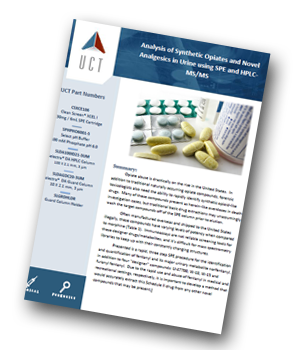UCT has produced an application note presenting a rapid, three-step SPE procedure for the identification and quantification of fentanyl and its major urinary metabolite norfentanyl, in addition to four “designer” compounds: U-47700, W-18, W-15 and furanyl fentanyl.
 Introduction
Introduction
Opiate abuse is drastically on the rise and in addition to traditional naturally occurring opiate compounds, forensic toxicologists also need the ability to rapidly identify synthetic opioid-like drugs. Many of these compounds present as heroin-like overdoses in death investigation cases, but traditional basic drug extractions may unassumingly wash the target compounds off the SPE column prior to elution.
Results and Discussion
Due to the large variation in fentanyl-like drugs mentioned in recent case reports, a panel of four emerging drugs of abuse were selected along with fentanyl and its major urinary metabolite norfentanyl for extraction and analysis. The universal SPE methodology was designed keeping in mind the continuously evolving target of designer opiate-like drugs and other novel analgesics. Executing a tandem wash scheme utilizing D.I. H2O followed by Acetic Acid provided removal of unwanted matrix components in addition to protonation of basic compounds, respectively, without the loss of hydrophobic analytes. A reduction in wash steps and elimination of column conditioning allows for an overall saving on both analyst time and solvent usage.
Conclusion
A fast and effective method was developed for the determination of six designer opiates in urine samples. All analytes of interest were extracted using a Clean Screen® XCEL I column. Analysis of the samples was performed by LC-MS/MS utilizing a Selectra® DA HPLC column which allowed for improved separation of furanyl fentanyl and fentanyl, when compared to other column phases. Absolute recoveries ranged from 72.9-125.3% for all three control levels tested.
Benefits of Method
With the unfortunate (and often unaware) abuse of synthetic opiates throughout the United States, it is critical that forensic laboratories have accurate and rapid SPE methods for the identification of this class of compounds. The proceeding method will be of great use as drugs with similar structures start to be found in casework.




